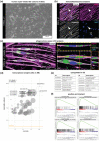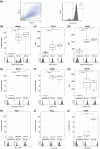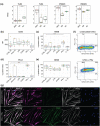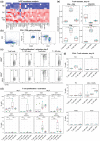Human repair-related Schwann cells adopt functions of antigen-presenting cells in vitro
- PMID: 36054432
- PMCID: PMC9804420
- DOI: 10.1002/glia.24257
Human repair-related Schwann cells adopt functions of antigen-presenting cells in vitro
Abstract
The plastic potential of Schwann cells (SCs) is increasingly recognized to play a role after nerve injury and in diseases of the peripheral nervous system. Reports on the interaction between immune cells and SCs indicate their involvement in inflammatory processes. However, the immunocompetence of human SCs has been primarily deduced from neuropathies, but whether after nerve injury SCs directly regulate an adaptive immune response is unknown. Here, we performed comprehensive analysis of immunomodulatory capacities of human repair-related SCs (hrSCs), which recapitulate SC response to nerve injury in vitro. We used our well-established culture model of primary hrSCs from human peripheral nerves and analyzed the transcriptome, secretome, and cell surface proteins for pathways and markers relevant in innate and adaptive immunity, performed phagocytosis assays, and monitored T-cell subset activation in allogeneic co-cultures. Our findings show that hrSCs are phagocytic, which is in line with high MHCII expression. Furthermore, hrSCs express co-regulatory proteins, such as CD40, CD80, B7H3, CD58, CD86, and HVEM, release a plethora of chemoattractants, matrix remodeling proteins and pro- as well as anti-inflammatory cytokines, and upregulate the T-cell inhibiting PD-L1 molecule upon pro-inflammatory stimulation with IFNγ. In contrast to monocytes, hrSC alone are not sufficient to trigger allogenic CD4+ and CD8+ T-cells, but limit number and activation status of exogenously activated T-cells. This study demonstrates that hrSCs possess features and functions typical for professional antigen-presenting cells in vitro, and suggest a new role of these cells as negative regulators of T-cell immunity during nerve regeneration.
Keywords: PD-L1; Schwann cell; antigen-presenting cell; immunocompetence; immunoregulatory; inflammation; nerve injury; neuropathies.
© 2022 The Authors. GLIA published by Wiley Periodicals LLC.
Conflict of interest statement
The authors declare no conflict of interest.
Figures




References
-
- Ambros, I. M. , Rumpler, S. , Luegmayr, A. , Hattinger, C. M. , Strehl, S. , Kovar, H. , Gadner, H. , & Ambros, P. F. (1997). Neuroblastoma cells can actively eliminate supernumerary MYCN gene copies by micronucleus formation–sign of tumour cell revertance? European Journal of Cancer (Oxford, England: 1990), 33(12), 2043–2049. 10.1016/s0959-8049(97)00204-9 - DOI - PubMed
-
- Arthur‐Farraj, P. J. , Morgan, C. C. , Adamowicz, M. , Gomez‐Sanchez, J. A. , Fazal, S. V. , Beucher, A. , Razzaghi, B. , Mirsky, R. , Jessen, K. R. , & Aitman, T. J. (2017). Changes in the coding and non‐coding transcriptome and DNA Methylome that define the Schwann cell repair phenotype after nerve injury. Cell Reports, 20(11), 2719–2734. 10.1016/j.celrep.2017.08.064 - DOI - PMC - PubMed
Publication types
MeSH terms
Substances
Grants and funding
LinkOut - more resources
Full Text Sources
Research Materials

